
Curated with aloha by
Ted Mooney, P.E. RET

The authoritative public forum
for Metal Finishing 1989-2025

-----
Problems in Gold plating
Q. Hi,
I was wondering if someone could explain (or link to a study or article) on the correlation between Gold content in tank plating solutions and micron thickness.
I have a low gold content solution (0.8 g/l), and I have been informed by the manufacturer that it can achieve maximum 1 micron thickness.
I asked the manufacturer what would happen if I did two layers, they said this was not possible but couldn't explain why or what would happen should it be attempted.
They did however say I could use their high thickness yellow gold solution to achieve a 1 micron yellow gold layer, then plate a 1 micron Rose layer over the top of this, to achieve the desired 2 microns.
I can't understand why it will plate a further 1 microns over the top of the yellow gold layer, but cannot plate a further 1 microns over a layer of the same kind.
Could anyone explain please?
If it cannot plate a second layer over itself, could I use a barrier layer between the two Rose Gold layers?
For example: Sterling Silver Base - Palladium (Nickel Alternative) Barrier layer - 1 Micron Rose Gold Layer - 0.1 Micron Yellow Gold Layer - 1 Micron Rose Gold Layer.
I am trying to understand the science behind why this would or wouldn't work, and what the issues would be should it be attempted.
(Said High Thickness Yellow Gold Solution isn't available in my country, trying to work within the confines of what is available. Cyanide based solutions from a different company are available however I would prefer to stick with Acid based)
Thanks
- Kent, England
October 29, 2021
by Reid & Goldie
-- hard to find & expensive; if you see a copy cheap, act fast!

on eBay or
AbeBooks
or Amazon
(affil links)
A. Hello Hayleigh. Some things that we understand about plating are based on crystal clear theory -- things that I like to call 'first principles'. Faraday's Law is the perfect example of this; it makes it absolutely clear & obvious that the plating thickness is directly proportional to the plating current times the plating time, and why. It lets you use simple arithmetic to answer all questions.
On the other hand there is empirical knowledge -- relationships that are based nearly totally on observation ('that's just the way things are') rather than a real scientific understanding. An example of that is the maximum satisfactory plating rate: although we appreciate general issues like boundary layer phenomena, adatoms, crystallization, temperature, ion migration, agitation, etc., we can't determine the maximum rate at which we can successfully plate by deep scientific calculation and understanding of these factors, but by knowing from past experience that exceeding a certain rate will result in burning rather than satisfactory plating, and having just a general acquired feel for the effects of those variables.
Solutions with low gold content are employed for reasons like: they don't 'immersion deposit' on the substrate, and they can be used as a 'garbage collection' step to trap impurities because they don't cost a fortune to replace. Appreciating this issue of empiricism, it can be hard to offer you a deep scientific explanation of why heavy gold plating from a low gold content solution tends to be a problem. It may be best to just accept that the type of deposit you will get from a low gold content solution (in terms of crystal size, porosity, hardness, etc.), just isn't highly compatible with thick plating.
Luck & Regards,

Ted Mooney, P.E. RET
Striving to live Aloha
finishing.com - Pine Beach, New Jersey
A. Hi Hayleigh
I had no problems plating 2 mm thick 80/20 gold/copper alloy on a regular basis.
BUT: I was not using 0.8 g/l. Probably 8.0 or more.
The value in the tank is eye watering at today's prices but you only use what you plate out. The problem with 0.8 g/l is that you rapidly deplete the gold in solution unless you are constantly replacing it - I assume that you do.
If your supplier says it cannot be done, I am guessing that you are buying from a jewelry supplier not a plating supply house. They buy in and sell on chemicals (with a mark up) but have very limited knowledge of the process.
Unless (unlikely) you are using a sulphite based solution, "acid" gold processes are based on GPC, Gold Potassium Cyanide but there is very little "free cyanide" in solution.
You might be interested in
www.academia.edu/10635761/Cyanides_in_Metal_Finishing_Risks_and_Alternatives
I cannot advertise but you can call the Institute of Materials Finishing for contact details of plating supply houses https://materials-finishing.org/

Geoff Smith
Hampshire, England
⇩ Related postings, oldest first ⇩
Q. We have been doing Nickel and Gold plating for some time now. It is for Brass Watch cases. Normally we are asked to do about 6 microns Bright nickel and an over coat of 2-3 microns of hard Gold. We have been using Acid gold bath with Gold Concentration of about 2-3 g/l and pH 4.2 Recently we shifted to a new premises and the solutions were transferred in carboys and later transferred to our plating cell (Natural PP). As it is normal, we did Activated Carbon treatment of the Gold bath because we wanted to eliminate any sort of contamination due to diffusion of particles from the HDPE carboys. Suddenly we find that the cases are too dull after Gold but does not have any such dullness in Nickel. Did some hull cells but no haze in the operating region of 2 ASD. Any suggestions ? Chandrashekar.
Chandrashekar- Bangalore, INDIA
1999
A. Sounds like the carbon treatment removed all or most of the gold brighteners. I'd do an analysis of the gold bath and determine brightener levels, or contact the bath manufacturer and advise him of the problem. I'm sure a simple replenishment of brightener will address the problem. .........BOB
Bob Denneyavionics Tampa, Florida
A. From personal experience I have found activated carbon treatment to cause similar problems, a dull finish. We filter our baths to help eliminate contaminations but generally stay away from the activated carbon. Also we have found that even slight adjustments in PH will make a major difference in appearance. Try lowering your PH to 4.0 or 4.1.
Michael Noel- Newville, Pennsylvania, USA
A. We think the active carbon treatment which you have given to your gold bath is a bit heavy. You should give 0.5 grams carbon per liter of gold solution, as your gold bath is cobalt hardened you need to replenish it with nickel standard solution so as to get the required shining, this nickel standard solution is easily available with your vendor, always keep the PH of the bath between 3.5 to 4, check it twice a day while work is going on.
Rohan Jaipal- Rajkot, Gujarat, India
2001
A. Dear Chandrasekhar,
There is nothing strange: replenish your electrolytes with brightener and additives as specified by the supplier. Initially, please increase your bath density by increasing GPC concentration, and adding density correction salts.
Good Luck

Shafiuddin A. Mohammed
metal coating shop - Dubai, United Arab Emirates
September 28, 2008
by C W Zanariah Ngah
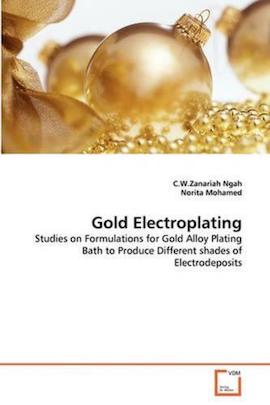
on eBay or
AbeBooks
or Amazon
(affil links)
Q. We are doing gold plating on watch cases in acid base bath having concentration of gold 3 to 4 grams per liter. we require to plate in the range of 0.1 to 3.0 micron thickness of gold. For this we run the show on assumption only keeping in mind approximate surface area of the article and then calculating the approximate weight of gold required to be deposited in achieving the required thickness. Is there any system that works automatically in the line and take care of the area to be plated and allow the required current to flow in the bath and switch off by itself after the required thickness is achieved. Thanks.
Rajveer singh- New Delhi, India
1999
Q. Hello
We are seeing white spots and haze on gold plated sterling silver jewelry. The plating recipe has Palladium 3-5 mils pH 8; Micron gold pH4 40 mils, and Gold flash pH 12.
There is no nickel or copper plating.
The reason for the marks seems to be porosity in the metal casting. If we burnish the metal, repolish and replate the issue most likely gets resolved. We are in search of an easier way/ideas/techniques to overcome the problem.
Of course the metal casting needs to be improved, however we would like to focus on whether we can make improvements during the finishing process.
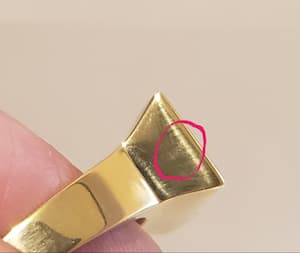
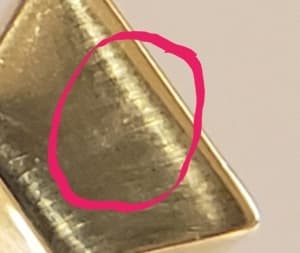
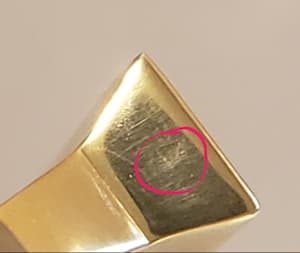
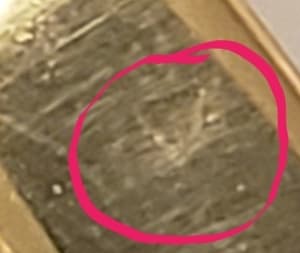
Wondering if nickel strike will help.
Never done nickel striking before -- not sure if jewelry will be Prop65 compliant, and also concerned about nickel allergy.
Any suggestions are welcome. Thank you.
- New York, NY
February 25, 2021
A. Hi James. Although I doubt that nickel would leach through over a micron of precious metal plating, your company has moved forward to palladium in lieu of nickel, and I'd hate to see you go backwards. Nickel has been banned in jewelry in Europe and much of the world for a long time ... and one of these days concern for the public health will trump the blather & perks of lobbyists and it will be banned in the USA as well.
I don't have experience with vacuum impregnation personally, but is a well known process for dealing with porosity. Basically, if you put parts under a vacuum, and get the air and everything else out of the hollows, when you release the vacuum whatever you make available will be pulled into those hollows. Hopefully someone more knowledgable in it will chime in to offer details.
Luck & Regards,

Ted Mooney, P.E. RET
Striving to live Aloha
finishing.com - Pine Beach, New Jersey
Q. Thank you Ted. Vacuum impregnation is very interesting. I wonder if machinery for jewelry application exist. Applications I checked online seem to be more for automotive industry and bigger objects in general.
Palladium is the way to go -- completely agreed. However recent price spike put a serious cost on using palladium for thick applications. We will try 40 mils platinum plating under gold -- as platinum is cheaper than palladium -- and post if we see any improvement.
We are still open to hear other ideas/comments from the finishing.com community for possible solutions.
- New York, NY
\
Q, A, or Comment on THIS thread -or- Start a NEW Thread